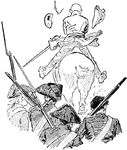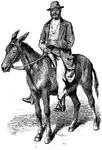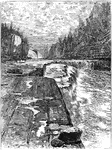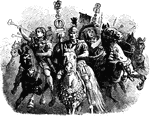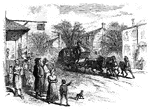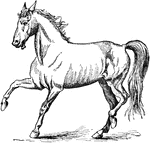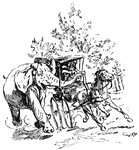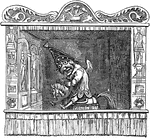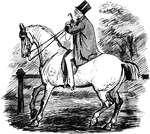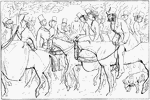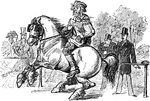
Short-Snouted Seahorse
The short-snouted seahorse (Hippocampus hippocampus) is a species of fish of the Syngnathidae family.

Porpita Pacifica
"The Porpitae consist of colonies of floating animals furnished with a cartilaginous, horizontal…
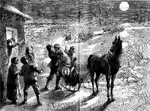
Winter Sleigh
A sled, sleigh, sledge is a vehicle used for transportation on surfaces with low friction, usually snow…
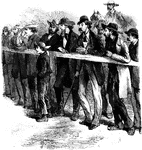
Men Watching Horse Races
A group of men resting against a fence watching the Greenville horse races.
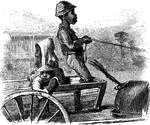
Boy and Buggy
An illustration of a young boy driving a horse drawn buggy with two other children riding.
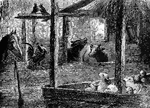
Barn Full of Animals
An illustration of a barn filled with animals, including: cows, a rooster, a horse, lambs, and birds.

Double Buggy
An illustration of a double buggy. Referred to as a double buggy because the buggy has two separate…

Battle of Azincourt
The Battle of Agincourt was an English victory against a larger French army in the Hundred Years' War.…
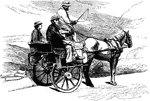
Jaunting Car
The Irish form of the sprung cart, called a jaunting car or jaunty car, was a light, horse-drawn, two-wheeled…

Street Car
An illustration of a horse-drawn street car. The first passenger services in the world were started…

Man and Horse
An illustration of a man riding a horse toward a windmill with a makeshift javelin, a play on Don Quixote.

Pile Driver
This pile driver is powered by a horse. The horse will pull a cord that raises the weight. When the…

Stagecoach and Prairie Schooner
"Modes of travel in the West. An old stage-coach and prairie schooner." -Gordy, 1916
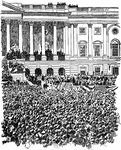
Inauguration of William McKinley
The inauguration of President William McKinley led by the Black Horse Cavalry down Pennsylvania Avenue.
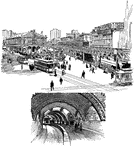
City Transportation
"Transportation in a large city, showing elevated road, surface line, and subway." -Gordy, 1916
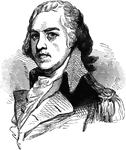
Henry Lee
Henry Lee III (January 29, 1756–March 25, 1818) was an early American patriot who served as the Governor…

James Longstreet
James Longstreet (January 8, 1821 – January 2, 1904) was one of the foremost Confederate generals…
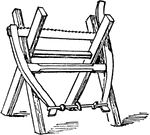
Sawhorse
A wood-saw hanging on a sawhorse, which is a legged beam to support a piece of wood while sawing.

Atlantic Horse Mackerel
The Atlantic Horse Mackerel or Scad (Trachurus trachurus) is a species of mackerel in the Carangidae…
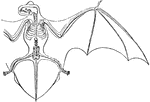
Skeleton and Wing Membranes of the Noctule Bat
The bat genus Nyctalus (Noctule bats) are Evening bats. They are distributed in the temperate and subtropical…

Bear Foot
"Palmar aspect of left fore foot of a black bear (Ursus americanus). scl, scapholunar; c, cuneiform;…
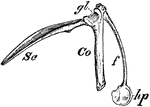
Bird Scapula
"Right shoulder-girdle or scapular arch of fowl, showing hp, the hypoclidium; f, furculum; Co, coracoid;…

Pike Scapulocoracoid
"Pectoral arch and fore limb of the pike (Esox lucius), an osseous fish, showing scapulocoracoid, composed…

Precious Coral
An illustration of part of a stock of precious coral (red coral). Precious coral or red coral is the…
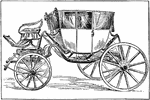
Washington's Coach
The coach that belonged to the first President of the United States, George Washington. A coach was…
Gill Arch and Plates
Section through the gill arch and plates of a bony fish. Labels: b, gill plates with capillaries; c,…

Skeleton of a Horse
The skeleton of a horse. Axial Skeleton. The Skull. Cranial Bones: a, occipital, 1; b, wormian, 1; c,…
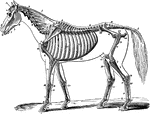
Skeleton of a Horse
The skeleton of a horse. Showing its relation to the contour of the animal, viewed laterally. Labels:…
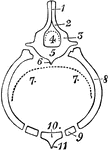
Diagram of Mammilian Thorax
Diagrammatic transverse section from the skeleton of a mammalian thorax, showing the chief features…
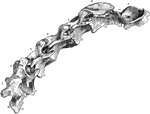
Horse Vertebral Column
Right lateral view of the cervical portion of the vertebral column of a horse. 1 to 7, the seven segments;…

Cervical Vertebra of a Horse
Right lateral view of a cervical vertebra of a horse. Labels: 1, neural spine; 2, anterior oblique processes;…

Bird Skull
"Schizognathous skull of common fowl. pmx, premaxilla; mxp, maxillopalatine; mx, maxilla; pl, palatine;…

Curlew Skull
"Schizorhinal skull of curlew (top view), showing the long cleft, a, between upper and lower forks of…
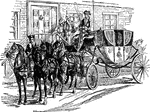
The President's Equipage
An elegant horse-drawn carriage with its retinue of servants is an equipage.

Horse Skull Seen from Above
The skull of a horse seen from above. Labels: I, occipital lobe; II, parietal bone; III, squamosal bone;…

Inferior Aspect of Horse Skull
Inferior aspect of horse's skull, the mandible being removed. Above the line A is the posterior region…

Lateral Aspect of Horse Skull
Lateral aspect of horse's skull. Labels: 1, occipital bone; 2, parietal bone; 3, frontal bone; 9, nasal…

Longitudinal Section of Horse Skull
Longitudinal section of a horse's skull. Labels: 1, supraoccipital bone and crest; 2, parietal bone;…
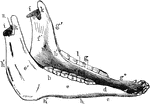
Inferior Maxilla of a Horse
Inferior maxilla of a horse-anterolateral view. Labels: a, body; b, b', rami; c, neck; d, mental foramen;…

